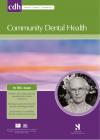Community Dental Health

- Cover Date:
- December 2011
- Print ISSN:
- 0265 539X
- Vol:
- 28
- Issue:
- 4
Malocclusion and orthodontic treatment need measured by the Dental Aesthetic Index and its association with dental caries in Indian schoolchildren
Objective: To assess prevalence of malocclusion and orthodontic treatment needs among 12 year old Indians using the Dental Aesthetic Index, and to find its association with dental caries. Method: 927 schoolchildren were randomly selected and their DAI and dentition status scores were recorded as per 1997 World Health Organization criteria. Clinical exams were carried out by one trained and calibrated examiner. The Chi–square test, Z-test and Spearman’s correlation test were carried out. Results: Mean DAI score was 19.2 (sd 6.8). Differences were found between male and female DAI scores (Z≤0.05). 82% of children had DAI scores <26 with no or minor malocclusion requiring no or little treatment, 3.2 % had DAI scores 31-35 with severe malocclusion requiring highly desirable treatment and 1.8% DAI scores >35 with handicapping malocclusion requiring mandatory treatment. A mean DMFT of 1.15 (sd1.62) was recorded. Severe and handicapping malocclusions were associated with dental caries. Conclusions: The distribution of DAI scores among Indian schoolchildren differs from that reported in other populations. Positive correlation was found between severe and handicapping malocclusion with dental caries.
Key words: malocclusion, DAI, dental aesthetic index, treatment needs, school children, dental caries
- Article Price
- £15.00
- Institution Article Price
- £
- Page Start
- 313
- Page End
- 316
- Authors
- A. Singh, B. Purohit, P. Sequeira, S. Acharya, M. Bhat
Articles from this issue
- Title
- Pg. Start
- Pg. End
- Why has oral health promotion and prevention failed children requiring general anaesthesia for dental extractions?
- 255
- 258
- Predictors of utilisation of dental care services in a nationally representative sample of adults
- 269
- 273
- Applicability of both dentist and patient perceptions of dentists’ explanations to the evaluation of dentist–patient communication
- 274
- 279
- Evaluation of a preventive program based on caries risk among mentally challenged children using the Cariogram model
- 286
- 291
- The effect of a modified fluoride toothpaste technique on buccal enamel caries in adults with high caries prevalence: a 2-year clinical trial
- 292
- 296
- Association of clinical oral health status with self-rated oral health and GOHAI in Japanese adults
- 297
- 300
- Prevalence of periodontopathogens in a black Brazilian secluded community matched with a black urban population
- 301
- 304
- Incisor trauma in a Turkish preschool population: Prevalence and socio-economic risk factors
- 308
- 312
- Malocclusion and orthodontic treatment need measured by the Dental Aesthetic Index and its association with dental caries in Indian schoolchildren
- 313
- 316
